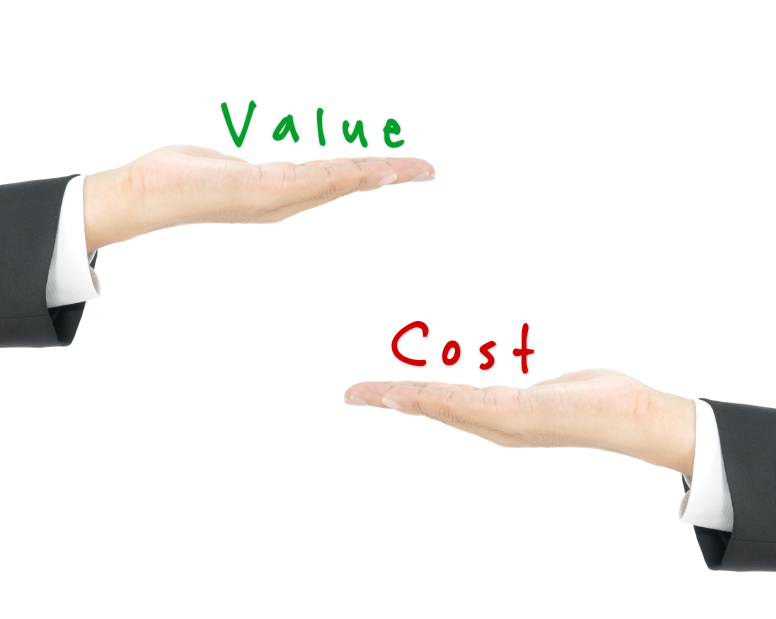Boosting Customer Received Value Through Lean
In our previous blog post, “3 Guiding Principles for the Application of Lean in Marketing & Sales”, we offered a trio of overriding Lean commandments. In this post, we point to specific Marketing & Sales targets for Lean that will simultaneously increase customer received value and marketing and sales ROI.
Target #1: Lean Applied to Market Focus
Face the facts. Your product or service offerings do not deliver the same economic, emotional, political or physical value to all market segments equally. Lean means focusing your products on market segments where the total value received by customers is its highest. If that situation exists, the Law of Economic Value is satisfied.
The Law of Economic Value states:
“All economic value accruing to your firm has as its source, the customer’s perception that they will receive more economic, emotional, political or physical value from your product or service, than it costs them economically, emotionally, politically or physically to acquire and use.” ©
Research shows that the following benefits accrue to a firm if the Law of Economic Value is fulfilled:
- the ability to garner price premiums
- faster market penetration
- higher customer satisfaction
- more market peer-to-peer customer communication of that value proposition
- higher interest in your product from channel partners
- higher probability of achieving market share leadership in that segment
- reduced marketing and sales expense
- improved sales win rate and faster time to close
- reduced product design costs and a clearer product evolution path
- greater returns from focused on line marketing investments
Market Focus is Lean in Action.
Target #2: Lean Applied to Product Requirements
Feature creep is the antithesis of Lean. It can be particularly nefarious in high tech firms where brilliant and creative engineers, encouraged and abetted by marketing and sales folks, attempt to stuff all the capabilities they can into a product to make sales as easy as possible.
The truth is, feature-stuffing typically causes delays in new product launches, ingrains price and profitability pressures in the product and results in a general market positioning of “everything to everyone in just one package”. Everything-to-everyone products inevitably lose market share to focused, niche offerings.
Focused Product Requirements are Lean in Action.
Target #3: Lean Applied to Marketing Communications
The wisdom of Lean and focused market communications is the toughest principle to convey to marketing and sales teams. The common fallacy is that, “more marketing expenditure is better than less”. Marketing and sales teams typically will fight tooth and nail to avoid reductions in this sacred budget arena. They believe that more marketing dollars across more expansive markets means more customers. Not so.
Research shows that communications of a new idea is best accomplished through peer-to-peer opinion leaders in a specific target market. That research revealed that peer-to-peer communication is 13 times more effectively than mass communication. Focused marketing communications programs that reach those opinion leaders, supported by value propositions achieved through market-focused product design, is the most economically productive combination that can be achieved.
Focused marketing communications is Lean in action.
Target #4: Lean Applied to Channel to Market
Your market share will eventually erode if your channel-to-market provides value only to you and not your customers. Marketers must be vigilant to assure their channel delivers meaningful and relevant value to customers and clients first.
Marketers must also recognize that the customer value the channel must deliver changes with the maturity of the industry. In a fledgling market the channel may be required to supply training, installation, configuration and integration services. In a mature market, those expensive services must be replaced by the channel’s ability to quickly deliver spare parts or service.
Evolving Channel Value Delivered is Lean in Action
Target # 5: Lean Applied to the Sales Process
An oft-cited statistic claims that 30% to 50% of the opportunities in the average sales person’s pipeline won’t close because the customer makes a decision to notbuy anything. The sales person has, in effect, wasted time and money pursuing something that was destined to never result in a sale.
We suggest a set of 5 criteria that can improve a sales person’s ability to qualify an opportunity and save time.
- The intensity of the customer’s need or problem,
- The degree to which the customer believes your product can meet that need,
- The degree of the economic, emotional, political or physical value the customer will receive by buying the product or service,
- The customer’s perception of your product’s relative competitive advantages ,
- The existence of a customer champion for your solution
Good Sales Qualification Discipline is Lean in Action.
Target #6: Lean Applied to Market Intelligence Feedback
Sound strategy cannot be developed without current and accurate market intelligence. Rapid response to market intelligence feedback is critical to business success. That intelligence may comprise some or all: competitive moves, customer satisfaction, barriers the sales people keep running into, the health of the customers’ markets, usage idiosyncrasies and a host of other informational tidbits. The sales team must be at the forefront of gathering this market intelligence. The sales team is the one company asset that is in the most frequent communication with customers.
Here are some thoughts about making your market intelligence gathering Lean:
- Create a market intelligence section as part of your sales person’s weekly or monthly sales report or presentations
- Train your sales people how to question, listen and observe when they are in front of a customer – not just spew the benefits of your product
- include providing market intelligence in the sales compensation plan and sales position descriptions
- provide the ability to award spot bonuses for the most timely and important pieces of information that come your way
- read the market intelligence reports; think about and acknowledge them by calling back the sales person who provided the information, thanking them and getting more information
- Understand what pricing pressure means. Pricing is typically a symptom of a bigger strategic problem, centered on customer-perceived value. Make your actions value-delivery related, not pricing related.
Rapid Collection and Response to Market Intelligence is Lean in Action
Conclusion:
The application of Lean principles to marketing and sales requires no major cash investment. In fact it saves cash. A firm of any size and market can deploy Lean in marketing & sales and begin to reap the economic rewards quickly.
Lean principles assure that customers receive the best value possible – and in return, consistent with the law of economic value, your business optimizes its own economic performance.
*****
Copyright Jerry Vieira, CMC and The QMP Group, Inc. All Rights Reserved
For more information on the application of Lean principles to Marketing & Sales, call Jerry Vieira, CMC at 03.318.2696 or visit the QMP Group website atwww.TheQMPGroup.com





